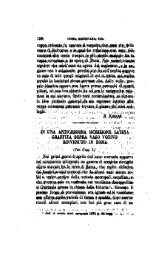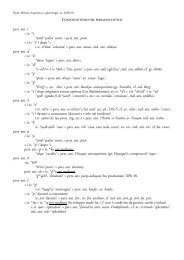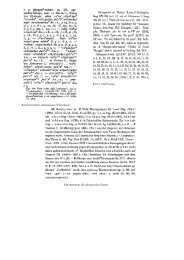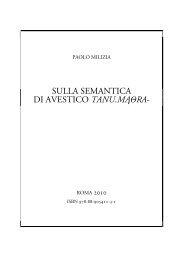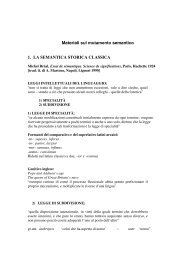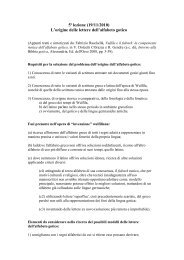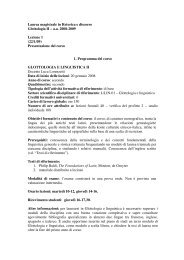Linguistic Society of America
Linguistic Society of America
Linguistic Society of America
Create successful ePaper yourself
Turn your PDF publications into a flip-book with our unique Google optimized e-Paper software.
THE INSCRIPTION OF DVENOS<br />
vase precedes the monophthongizing <strong>of</strong> the diphthong, and there is no<br />
other likely etymology for mitto than that which derives it from *mito,<br />
and this from a still earlier *meito, presumably from *smeito. The early<br />
subjunctive would then be *MEITAD, not MITAT. Even the concession<br />
<strong>of</strong> an entering variation in the ending does not free us from the problem<br />
<strong>of</strong> the diphthong.<br />
But it is possible that there were two present formations from this<br />
root.25 We find d1cere indicere and dicare indfcdre, ducere educere and<br />
educdre; there may have been a *mXtdre alongside *meitere *mtere<br />
mittere. This *mtdre yields a present indicative mltat, properly represented<br />
in our text; there is no difficulty about the final T, nor about<br />
the radical I, nor about the syntax <strong>of</strong> the mood.26<br />
The remainder <strong>of</strong> this line <strong>of</strong> the inscription was quite properly divided<br />
by the first editors, and was interpreted by them ne te intus comes virgo<br />
sit, wherein te is object <strong>of</strong> the phrase comis sit=comitetur: 'let not a<br />
maid accompany thee within (to the ceremonies)'. Osth<strong>of</strong>f 27 and Jordan28<br />
recognized that COSMIS could not be the old form <strong>of</strong> comes, but<br />
was the old form <strong>of</strong> comis, and Jordan29 and Breal30 independently took<br />
TED ENDO as in te. The VIRCO, with all the earlier editors, was a<br />
human maiden; Conway31 first noted that this whole clause is a translation<br />
<strong>of</strong> the Greek g7 eiXaroa6s ?oL d Kop71, which may reasonably be<br />
inferred from its converse /'1 TVrXOL Ac/Iarpos Kal [K]6pas JLsjC Oe.v irap&<br />
A6Ltiarpos eviXarcow and other like phrases in the Cnidian curses.32 VIRCO<br />
therefore means Proserpina, as goddess <strong>of</strong> Hades; and though this<br />
interpretation has been accepted only by Lindsay,33 Hempl,34 Miss<br />
25 Cf. P. G. Goidanich, Riv. di storia antica, n.s., 5. 233 [1900].<br />
26 Perhaps such a formation lurks in the deponent imftdri, which may be for *in-mltari,<br />
even as *ob-mittere has become omittere; for the meaning, *in-mitdri may well mean 'to let<br />
one's self go into (something), to identify one's self with, to imitate', cf. Plaut. Cas. 443<br />
recessim dabo me ad parietem, imitabor nepam 'I'll draw <strong>of</strong>f backwards to the wall, I'll<br />
imitate a crab'. Of course, such an etymology <strong>of</strong> imitdrl separates it from aemulus and<br />
imago.<br />
27 RhM 36. 482-4 [1881].<br />
28 Hermes 16. 233-8 [1881].<br />
29 Hermes 16. 235.<br />
213<br />
30 Mel. 2. 155 =Rev. Arch. 44. 89 [1882].<br />
31 AJP 10. 453 [1889].<br />
32 A. Audollent, Defixionum Tabellae, pp. 5-19, esp. No. 4; Paris, 1904.<br />
33 Short Historical Latin Grammar, ed. 1, 175, Oxford [1897], ed. 2, p. 199 [1915];<br />
Handbook <strong>of</strong> Latin Inscriptions 19-23, Boston, 1897.<br />
34 TAPA 33. 150-69 [1902].



